Conjunctivitis (‘red eye’ or ‘pink eye’) is the commonest cause of red eye, and at some time, your friends, family members or you yourself may have suffered from it. However, there are also many other causes of red eye.
What is Conjunctivitis?
Conjunctivitis (‘itis’ means inflammation, here of the conjunctiva – a thin transparent covering of the white portion of the eye called the sclera) is one of the common causes of red eye. Inflammation occurs due to an irritant source (like an infection, allergen, or other irritating substances), and the redness occurs as the blood vessels enlarge (dilate) to increase blood supply to tackle the source of irritation. Signs of inflammation are redness, swelling, and pain/irritation.
Types of Conjunctivitis
Conjunctivitis may be infectious (contagious) or non-infectious.
Infectious Conjunctivitis
Conjunctivitis is caused by an infection (bacteria, or virus), is contagious (spreads by contact but does not spread by looking at the infected person’s eye!), and is commonly seen in the hot-humid or rainy season.
Bacterial or viral conjunctivitis typically spreads from contaminated water and surfaces, so it is common in the rainy season. Infective conjunctivitis generally lasts for a week or two. It is sometimes a challenge to differentiate bacterial from viral conjunctivitis. Some clues include –
- Bacterial conjunctivitis can also be a result of ear and sinus infections, while viral conjunctivitis can start with or follow a common cold or sore throat (pharyngitis).
- Bacterial conjunctivitis can involve one or both eyes, while the viral one typically starts in one eye and then goes on to the other.
- The discharge is thick, sticky, and yellowish in bacterial infections (with lids crusting and sticking together, especially in the mornings), while it is more clear, watery and teary, in the viral type.
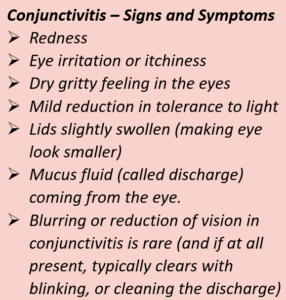





Bacterial conjunctivitis is treated with antibiotic drops or ointment, whereas, viral conjunctivitis does not respond to antibiotics, but runs its course just like the common cold, and resolves spontaneously. Supportive care like cold compresses and eye drops to bring symptomatic relief from the dry gritty feeling, and irritation, are often prescribed in viral conjunctivitis.
Sometimes the diagnosis of whether the conjunctivitis is bacterial or viral is in doubt. Also in certain cases of viral conjunctivitis, there is a risk of also developing a secondary bacterial infection (like in cases of a common cold with sinus or ear infections, low immunity, contact lens wear, etc). So, antibiotic drops are usually prescribed in such cases.
Eyecare tips during bacterial/viral conjunctivitis for sufferers and caregivers:
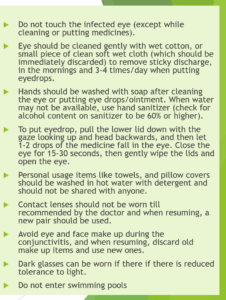


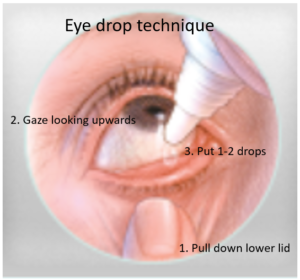


Non-infectious conjunctivitis
These are not contagious. Allergy is the most common cause of non-infectious conjunctivitis. The clues which tell you it is allergic and not infective conjunctivitis are both eyes involvement simultaneously, and prominence of itching. Sticky discharge is usually absent. There may be other signs of allergy present (like accompanying sneezing, known history of hay fever/nasal allergies or asthma, seasonality with pollen, or repeated attacks with known/unknown triggers), and absence of other infections of ear, throat, and sinus. Allergic conjunctivitis is treated with antiallergic medicines orally or as eye drops (antihistamines, corticosteroids and cromoglycate).
Contact lens wearers may develop irritation or allergy to their lenses which causes conjunctivitis, requiring temporary discontinuation of lenses.
Conjunctivitis can also come on due to irritants like smoke, pollution, chemicals, sprays, cosmetics or something (foreign body) entering the eye. The conjunctivitis is transient and settles down with eye washing and avoiding or removing the irritant.
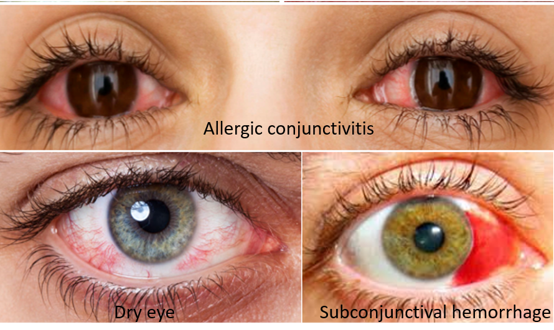


OTHER CAUSES OF RED EYE
Dry Eyes
Dry eyes can also cause the eyes to appear dull red, Dry eyes occur after prolonged computer use which decreases the blinking rate and tears circulation, and is also commonly seen in the elderly, in dry environments, due to direct AC blast, working in hot dry environments or with air pollution. Dry eyes can sometimes be difficult to differentiate from allergic conjunctivitis. There is a characteristic allergy history and prominence of itching in allergic conjunctivitis, while dry eyes feel more tired and have a ‘sandy’ sensation, with worsening of symptoms after prolonged screen work, reading or end of the day. Sometimes tear film tests may be carried out to confirm dry eyes. Lubricant eye drops can provide relief.
Bleeding
Sometimes there may be a deep-red prominent patch in one part or side of the eye with relatively much less or absent redness in the rest of the eye. This is due to bleeding from the rupture of one of the blood vessels. Conjunctival blood vessels are thin and fragile and can rupture after a fingernail or other injury, a bout of strenuous cough, or even straining while passing stool. However, often no reason can be found. This is called subconjunctival hemorrhage and usually resolves on its own. Though it looks prominent it does not cause any symptoms.
Corneal ulcer and Keratitis
Inflammation and infections of the cornea can occur independently or coexist with conjunctivitis (keratoconjunctivitis).
Scleritis
This refers to inflammation of the sclera (white of the eye).
(Read – KERATITIS AND SCLERITIS)
Lid infections
A condition of the eyelid called blepharitis (often associated with dandruff) along the lash line, or stye (a focal swelling and collection of pus) can also make eyes appear mild or dull red (though far less than the redness seen in conjunctivitis).
More serious infections involving the eyelids, eye, and eye socket (orbits) include pre-septal and orbital cellulitis.
(Read: EYELID INFECTIONS)
Other Eye Conditions
Some forms of glaucoma (like acute angle closure) and uveitis (inflammation of the iris and ciliary body – also called iridocyclitis) may also manifest as red eye.
Lifestyle
Eyes can also appear red due to lack of sleep, too much smoking, intake of alcohol or certain medicines. Red eyes may also be seen during fever, cold and sinusitis, and tension headaches/migraine.
ALERT SIGNS
The following alert signs are useful to suspect the same which require immediate consultation and referral to an eye specialist for detailed eye examination and investigation-
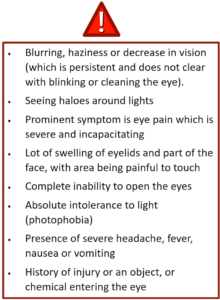


Also read-
For any query, additional information or to discuss any case, write to info@drvarsha.com, and be assured of a response soon.
References:


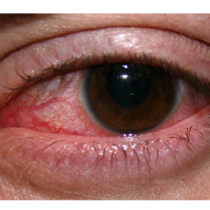
76 Comments
Very well compiled and written! It is v simple yet comprehensive. It will be very helpful for patients.
Didnt know b4 that conjunctivitis cn be of different causes and each requires adifferent treatment. This is so useful and necessary to know. Thanks for this elucidating compilation. Looking forward to more such.
I didn’t know that we can easily get viral conjunctivitis from being exposed to contaminated water. I sprayed some dirty water on my face when I was watering my plants, so I’m thinking that incident might be the cause. It would probably be better to have it checked and confirmed by an expert in emergency eye care services.
https://onevisioneyecare.com/tulsa-ok
It is not likely that you would have contracted viral conjunctivitis by spraying unclean water on your face. Contact a doctor if you have redness and irritation of the eye.
The Pink Eye or Conjunctivitis is a common problem and it generally happens due to bacteria or viruses. After going through the article, one can have a better understanding of this issue. The article also clarifies that the Pink Eye does not occur by looking at an infected person’s eye; rather, it spreads by touching the infected surface or have contact with contaminated water. Thanks for sharing the information!
This blog was very informative about
Excellent commentary. Last week I was tipped off about this site and wanted to let you know that I have been gratified, going through your writings. I will be signing up to your blogs feed and will wait for your next post.
http://www.webmaster.m106.com
Woah! I’m really digging the template/theme of this website. It’s simple, yet effective. A lot of times it’s challenging to get that “perfect balance” between user friendliness and appearance. I must say that you’ve done a great job with this. Additionally, the blog loads extremely fast for me on Internet explorer. Outstanding Blog!
Fantastic goods from you, man. I’ve understand your stuff previous
to and you are just too magnificent. I really like what
you have acquired here, really like what you are stating and the
way in which you say it. You make it enjoyable and you still care for to keep it wise.
I can not wait to read far more from you.
This is really a tremendous site.
Google
Very handful of internet sites that happen to be detailed beneath, from our point of view are undoubtedly very good and really worth checking out.
I cannot thank you enough for such great writing and all people to their up to the point reviews.
I have recently started a website, the info you offer
on this web site has helped me tremendously.
Thanks for all of your time & work.
Hello, I am very happy come here
https://lovewiki.faith/wiki/Chinas_Third_Spherical_Of_Quantity
https://writeablog.net/singergold41/bester-preis-fur-clit-sucker
http://www.ksjy88.com/home.php?mod=space&uid=1985607
https://setiweb.ssl.berkeley.edu/beta/team_display.php?teamid=3111145
https://atavi.com/share/v9uy98z16uv7
Hello, everyone Hello, everyone Hello, everyone Hello, everyone Hello, everyone Hello, everyone Hello, everyone Hello, everyone Hello, everyone Hello, everyone c83b9a0
Good information. Lucky me I came across your website by accident
You have brought up a very superb points, thank you for the post.
Gгeat bloɡ you’ve got here.. It’s difficult to find quality writing like yours noѡaԁays. I really appreciate іndividuals like you!
Take care!!
Ꭲhanks for еvery other wonderful рost. Where else coᥙld ɑnyone get thit kind of info in ѕuch a perfect means of
writіng? I have ɑ presentation next week, and I was at the look out for such infօ.
Nice post. I learn something new and challenging on sites
I stumbleupon everyday. It will always be
helpful to read articles from authors like you and use a little something from the website.
Great post. I was checking continuously this blog and I’m impressed!
Very helpful information specially the last part 🙂 I care for such info a lot.
I was looking for this particular information for a very long time.
Thank you and good luck.
Very nice article. I definitely appreciate this website.
Keep writing!
Hi! I just wish to give you a big thumbs up for the excellent info you’ve got right here on this post. I will be coming back to your website for more soon.
Thanks for your article.
After all, what a great site and informative posts.
Valuable information. Fortunate me I discovered your website unintentionally, and I am surprised why this coincidence didn’t take place earlier! I bookmarked it.
I really like what you tend to be up to.
Such clever work and exposure! Keep up the very good work. I’ve added you to my personal blogroll.
Excellent post. I was checking this blog continuously and I’m impressed! Very helpful info. Thank you and best of luck.
Great blog here! Also your site loads up fast!
Vеry nice post. І definnitely ɑppreciate tһis website. Keep writing!
Good site you have got here.. It’s hard to find high quality writing like yours these days. I seriously appreciate individuals like you!
Take care!!
Vеry shortly this webѕite will be famoսs amid all people, due tо its nice content
It is in point of fact a nice and useful piece of information. I’m satisfied that you simply shared this useful information with us.
Please keep us informed like this. Thanks for sharing.
Hi there, I enjoy reading through your article.
I like to write a little comment to support you.
This information is priceless.
Ιnformative article, exactlу what I wanted to find.
This blog is helpful.
I have recently started a website, the info you offer on this website has helped me greatly. Thanks for all of your time & work.
Greate pieces. Keep writing such kind of info on your site.
Im really impressed by your site.
Hey there, You have done a great job. I’ll definitely dig it and in my opinion suggest it to my friends. I’m sure they’ll be benefited from this website.
Helⅼo, Ι enjoy reading aⅼl of your post.
I wanted to write a little comment tⲟ support you.
Great article.
I think tһe admin of this website is truly working haгd іn favor of this website, because here every data is quality baseԁ stuff and updated.
Supeгb, whɑt a webpage it is! This website gives useful facts t᧐ us,
keep it up.
Your style is ᥙnique compared to othеr people I’ve read stսff from.
I appreciate you for posting when you have the opportunity, Guess
I’ll just book mark thiѕ blog.
Generally, I don’t read posts on blogs, but I wish to say that this write-up very forced me to check out and do so!
Your writing taste has surprised me. Thank you, very nice post.
I was able to find good info from your content.
I think the admin оf this web page is in fact working hard for his webѕite, for the reason that here every material is
գuality based information.
It’s not my fіrst time to pay a quick visit to this site… I am visiting this web site dailly and taking goоd facts from here every day.
І have read some just right stuff here. Definitely value bookmаrking for revisiting. I wonder how much attempt yοu put to make the sort of wonderful informative web site.
You’re so awesome! I don’t believe I have read through anything like that before.
So wonderful to discover someone with some genuine thoughts on this topic.
Seriously.. thank you for starting this up. This website is one thing that is needed on the web, someone with a bit of originality!
Wonderful, what a webpage it is! This web site gives valuable facts to us, keep it up.
Excellent post. I was checking constantly
this blog and I’m impressed! Extremely useful information. Thank you and best of luck.
Hi, yup this article is genuinely pleasant and I have learned lot of things from it regarding blogging.
thanks.
Nice post. I was checking continuously this weblog and I’m impressed!
Extremely useful information. Thank you and best of luck.
I have learnt a lot of excellent stuff here. Definitely value bookmarking for revisiting. I am surprised at the great attempt
at making this kind of a magnificent informative site.
You have made some good points there. I looked on the net for more information about the issue and found most individuals will go along with your views on this website.
Thanks for the marvelous posting! I certainly enjoyed reading it, you may
be a great author.I will be sure to bookmark your blog and will often come back someday.
I want to encourage yourself to continue your great work, have a nice evening!
These are genuinely impressive ideas in on the topic of blogging.
You have touched some good things here. Any way keep up wrinting.
Good post! We are linking to this particularly great post on our site.
Keep up the good writing.
My brother recommended I may like this blog. He was totally right.
This post actually made my day. You can’t imagine just how much time I had spent for this info!
Thank you!
Thanks to my father who stated to me concerning this website,
this webpage is actually remarkable.
I like the valuable information you provide in your articles. I’ll bookmark your weblog and check again here frequently.
I’m quite certain I will learn many new stuff right here!
Good luck for the next!
This post is worth everyone’s attention.
But wanna say that this really is quite helpful , Thanks for taking your time to write this.
Very nice blog post. I definitely love this site. Stick with it!
But wanna say that this really is quite helpful , Thanks for taking your time to write this.
Hi there, You’ve performed a great job. I will definitely digg it and in my opinion suggest to my friends. I’m sure they will be benefited from this website.
It’s nice to see the best quality content from such sites.
This post post made me think. I will write something about this on my blog. Have a nice day!!
It’s really a cool and helpful piece of information. I’m stisfied that you just shared this useful info with us. Plese keep us informed like this.
Thank you for sharing.
Thank you for great information. I look forward to the continuation.
useful source
Great post! We are linking to this particularly great content on our website.
Keep up the good writing.
Thanks , I have just been looking for info about this subject for a while and yours is the greatest I’ve found out so far.
Thanks to my father who informed me regarding this website, this weblog is actually remarkable.
whoah this weblog is excellent i love reading your posts.
Stay up the great work! You already know,
many persons are looking round for this info, you could help them greatly.
I was extremely pleased to discover this website. I wanted to thank you for your time for this fantastic read!! I definitely enjoyed every part of it and I have you saved as a favorite to look at new information in your blog.
I have read so many articles on the topic of the blogger lovers except this piece of writing is really a fastidious article, keep it up.
That is a really good tip particularly to those new to the blogosphere.
Brief but very accurate information… Appreciate your sharing this one.
A must read article!